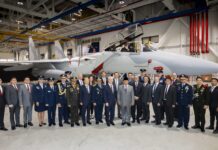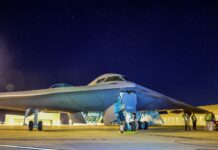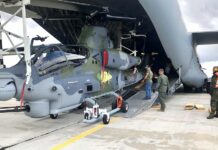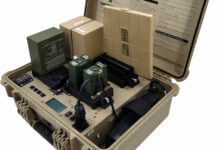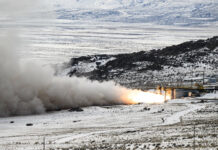Strategic bombers are designed for deep penetration missions into enemy airspace to destroy high-value targets in order to significantly degrade the opponent’s warfighting capability and will. While the term “strategic bomber” is often used synonymously with nuclear armed bomber, conventionally armed aircraft are equally capable of striking strategically significant targets deep within enemy territory.
The United States Air Force (USAF) is the only western service to operate strategic bombers. They form part of the US nuclear triad, augmenting Intercontinental Ballistic Missiles (ICBMs) and Submarine Launched Ballistic Missiles (SLBMs). Official US nuclear doctrine eschews a no-first-use policy on the ground that it could undermine the credibility of US security guarantees for allies, and maintains that the nuclear deterrent is a bedrock of US national security. At the same time, Washington tends to present the US nuclear arsenal in terms of a strategic deterrent. The maintenance of a triad rather than a one- or two-element nuclear force is said to enhance this deterrent function by providing flexibility, survivability and redundance should deterrence fail and deployment of nuclear weapons become necessary.

Photo: US Air Force / Zachary Wright
Strategic Bomber Vulnerabilities
The renewed focus on great power rivalry and conflict has reinvigorated the significance of the US strategic deterrent and strategic operational capabilities. The Pentagon is pursuing upgrades of the current strategic systems and is also pursuing acquisition of new, high-performance strategic weapon systems designed to keep pace with offensive and defensive developments in rival nations. Given the scarcity of resources and the long-standing debate in the United States regarding the appropriate strategic posture and force mix, it is inevitable that pundits question the necessity of retaining three strategic arms. Strategic bombers have frequently been singled out as potentially superfluous.
Several arguments have been made regarding purported drawbacks of strategic bombers, especially when compared to the stealthy and highly survivable strategic ballistic submarine leg of the triad. These arguments include: The home and forward operating bases of strategic bombers are known; this makes the planes and their support infrastructure vulnerable to preemptive attack. Unlike ICBMs and SLBMs, bombers performing an attack run require additional support forces including aerial refuelling. While an ICBM needs 30 minutes to destroy a target, aircraft need many hours to approach their weapons deployment zone; the enemy has considerable time to detect and monitor the bomber, and take defensive measures. In this context, bombers are vulnerable to air defence missiles, interceptor aircraft, electronic warfare and even electromagnetic pulse bursts; this raises questions about their capability to reach well-defended targets in the current age of high-performance air-defence systems.

Photo: U.S. Air Force / Jerreht Harris
Flexible Option for Great Power Conflict
Advocates of strategic airpower counter these arguments. Home bases and forward operating locations can be protected by air- and missile-defence artillery; additionally, they argue, pre-emptive strikes on bomber bases alone would make little sense as long as the US retains its nuclear missile forces. While bombers might be detected by enemy satellites or long-range sensors, this does not automatically reveal their target; aircraft can change course multiple times before releasing their payload. This gives them the ability to remain unpredictable and to pursue numerous angles of attack, unlike ballistic missiles which – to date – must remain on a set trajectory. While enemy air defences are increasingly sophisticated and far-reaching, modern bombers frequently deploy cruise missiles rather than gravity bombs, enabling them to release their ordnance from the edge of the enemy’s effective air defence zone. In aggregate, the offensive capacity of strategic bombers continues to exceed their vulnerabilities.

In addition to their basic combat power, strategic bombers feature a level of flexibility, which significantly enhances their importance. This begins with payload options. While ballistic missiles can be armed with a wide variety of payloads ranging from a few kilotons to more than a megaton, switching warheads is complicated and time consuming; loading a mission specific selection of nuclear or conventional ordnance on a bomber offers significantly greater flexibility. More important, however, is the ability to deploy bombers as highly visible power projection platforms short of warfare. A president can signal resolve by deploying them to a crisis zone or ordering them to fly near another nation’s airspace in an effort to encourage de-escalation, or to dial up pressure to match an opponent’s intimidation tactics. And should a president feel the need to order a strategic strike, there remain several hours for continued analysis or negotiation before the aircraft reach their launch zone. Unlike missiles, bombers can be recalled at any time prior to weapons release.
This flexibility alone proves the strategic bomber’s continued relevance. The return of great power conflict underscores the need to retain a robust, balanced strategic triad of mutually reinforcing elements.

The Current Bomber Force
USAF’s current strategic bomber fleet consists of three aircraft types: the B-52 STRATOFORTRESS, the B-1 LANCER, and the B-2 SPIRIT.
B-52H STRATOFORTRESS
The first B-52 bombers achieved Initial Operational Capability (IOC) in 1952. The extant aircraft operating today belong to the B-52H variant, of which 102 units were acquired in 1961-1962. The current active duty force consists of 58 planes, of which four are reserved as test aircraft. An additional 18 units are operated by the Air Force reserve. The fact that the B-52 still constitutes the backbone of the US strategic bomber fleet – and is effectively being flown by the grandchildren of the original pilots – attests to its robustness.
The B-52H has an operational ceiling of 15,000 metres, achieves speeds of Mach .84, and has an operational range of 7,500 nautical miles (NM). The payload capacity is 31,500 kg carried inside the bomb bay and on underwing pylons. The plane carries both cruise missiles and gravity bombs, and is rated for both conventional and nuclear ordnance. Since the plane cannot penetrate modern air defence systems, it can only engage strategic targets by deploying stand-off weapons. The B-52 can carry up to 20 AGM-86B nuclear armed cruise missiles with a range of circa 1,500 NM, or up to 12 nuclear-capable, stealthy AGM-129A cruise missiles with over 2,000 NM range. The STRATOFORTRESS will also deploy the Long-Range Stand-Off (LRSO) nuclear armed cruise missile which is expected to replace the AGM-86B by 2030. The LRSO’s combination of speed, manoeuvrability and stealth-configuration is expected to enable deep penetration of enemy air- and missile defences even when launched by non-stealthy aircraft. The combined range of strategic bombers and the LRSO will permit engagement of targets at any spot on the globe.

Photo: U.S. Air Force / Hannah Malone
Ongoing and planned modernisation will extend the B-52H’s service life into the 2050s. Currently the bombers are being outfitted with new Rolls Royce F130 engines. In January 2022, Collin Aerospace announced a contract to upgrade the B-52’s power generation system. Taken together these upgrades will reduce fuel consumption by 30 per cent, extend mission range and loiter time, and permit faster ascension to cruising altitude. The increased power production associated with the new equipment will support future upgrades including new Active Electronically Scanned Array (AESA) radar, as well as upgraded avionics, pneumatics and defensive systems.
B-1B LANCER
The B-1 LANCER achieved IOC in 1986. The blended wing/body configuration, variable-geometry wings and supersonic-flight-capable engines combine to make the aircraft highly manoeuvrable at both low and high altitude. The LANCER holds nearly 50 class-specific world records for speed, payload, range, and climb rate. Performance parameters include a 9,150 metre service ceiling, Mach 1.2 top speed, and “intercontinental” mission range. The currently deployed B-1B’s 34,000 kg payload capacity is the largest of any US combat aircraft. Originally a dual-capable bomber, the B-1 was converted in 2007-2011 to exclusively carry conventional ordnance. Operationally the LANCER is still capable of attacking strategically significant targets from stand-off range using the low-observable AGM-158A JASSM cruise missile (range 230-1,200 NM depending on variant).

B-2 SPIRIT
The B-2 SPIRIT, which entered service in 1997, is USAF’s only strategic bomber with fully-developed stealth characteristics encompassing reduced acoustic, thermal, electromagnetic, radar and visual profiles at all altitudes. As such, it is the only true deep-penetration bomber currently in the fleet. However, USAF expects peer-level adversaries’ developmental air defence systems to diminish the effectiveness of the B-2’s low-observable technology in coming years.
The aircraft has an unrefuelled 6,000 NM operating range, and has in the past self-deployed directly from the united States to the Balkans or Afghanistan, conducted ground strikes, and returned to its home base without landing. The 18,150 kg payload encompasses nuclear and conventional weapons including B61 and B83 variable-yield thermonuclear gravity bombs and the conventionally armed JASSM. Original plans had called for 135 aircraft, but the end of the Cold War induced the Pentagon to cap production at 20 operational units.

The 21st Century Bomber
The B-1 and B-2 will begin to retire in the 2030s as the new B-21 RAIDER bomber enters service. These earlier-than-planned retirements reflect the budget- and manpower-driven need to maintain a steady-sized total bomber force of approximately 175 aircraft (although such top-level figures are subject to change, and have recently trended upward). USAF’s choice to replace the two younger airframes rather than the B-52 reflects the latter’s large and versatile payload capability, simpler maintenance, and – not least of all – the ability to deploy new long-range weapons currently being developed.
The B-21 is being designed by Northrop Grumman to operate in a highly contested environment marked by advanced enemy sensors and air defence systems. Its stealth technology will be three decades more advanced than that of the B-2, and is expected to enable deep penetration missions even against peer-level opponents. The open-architecture design will facilitate frequent upgrade of aircraft systems to ensure that the aircraft’s capabilities keep pace with new technologies and quickly adapt to changes in the threat environment. Most technical and performance details of the new bomber remain classified. Concept graphics released by the Air Force show a batwing design similar to the B-2; some analysts conclude that the depicted RAIDER appears somewhat smaller than the SPIRIT.
The RAIDER will accommodate a broad range of nuclear and conventional stand-off and direct-attack munitions. The operating concept calls for integrating the bomber with various support platforms including Intelligence/Surveillance/Reconnaissance assets. Unmanned combat aircraft and electronic warfare aircraft, controlled by the B-21 crew, will escort or collaborate with the bomber, according to statements made by Air Force Secretary Frank Kendall in December 2021. The B-21 itself will be configured for optionally manned or unmanned operation, although that capability will not be found on the earliest production aircraft.
The first six aircraft are currently in production, with the first unit nearly complete externally. This first test aircraft is reportedly halfway through ground testing, having successfully completed the first and most critical load calibration test. Flight-line ground testing – including testing of engines and high-speed taxi tests – are expected over the coming weeks to months. First flight has been postponed to 2023, a delay of approximately six months. Neither USAF nor Northrop Grumman provided a reason for the delay, saying in May 2022 that the programme remains within the established cost, schedule and performance baselines.
USAF continues to estimate mission availability of the first aircraft in the “mid-2020s”. While the production rate remains classified, Northrop Grumman revealed in April 2022 that the Low-Rate Initial Production phase will begin in 2023 and run concurrently with the Engineering and Manufacturing Development phase “for a period of time” in order to accelerate acquisition; full-rate production should begin in the 2025-2026 timeframe. USAF’s official acquisition goal is a minimum of 100 aircraft (and perhaps as many as 145). When inventory reaches sufficient depth it will relieve the B-52 as the backbone of the US strategic bomber force, but will continue to partner with the STRATOFORTRESS, with each aircraft’s respective strengths contributing to the comprehensive mission.
Are Unmanned Bombers Over the Horizon?
In addition to the optionally manned B-21, USAF also plans to introduce a cheaper, fully unmanned bomber to partner with the RAIDER. Speaking at the Air Force Association Airpower Symposium in March 2022, Air Force Secretary Kendall introduced the concept of the “B-21 long-range strike family of systems” with an unmanned strategic bomber complementing the B-21. The unmanned component would need to match the B-21 in range and speed, and have a “reasonable payload.” Kendall stressed that concept development is in early stages, and that no decision had been made regarding nuclear or conventional payloads for the “potentially attritable” UAS.
Speaking at the same forum, Randall Walden, director of the Rapid Capabilities Office, which oversees the B-21 development, confirmed that USAF is serious about developing the unmanned bomber. He postulated that the UAS could act as a pathfinder for the B-21, neutralising enemy air defences for the manned bomber. “We would take more risk with an unmanned system that is not as expensive as the manned system,” he said. The Pentagon plans to request research and development funding for the unmanned aircraft in 2023 and 2024. If the risk reduction phase and design competitions provide positive results, the UAS could be available by the end of the current decade, Walden said, adding that his office “is pretty good at doing that piece in a relatively fast way.”
Sidney E. Dean






